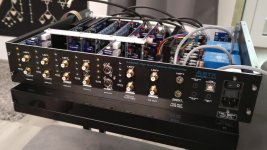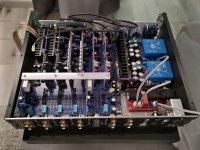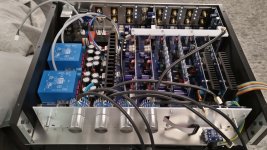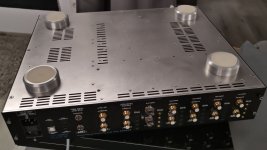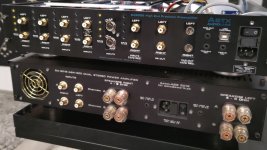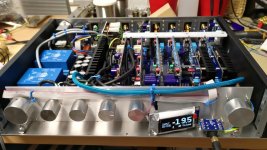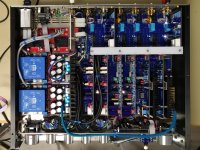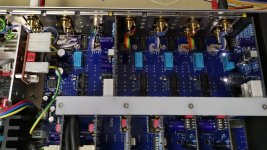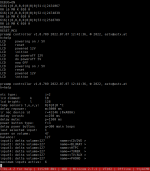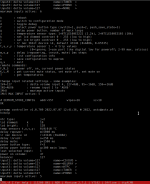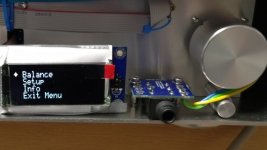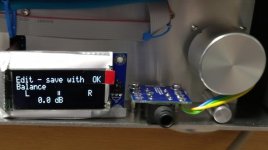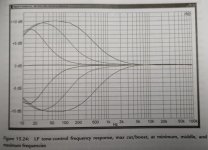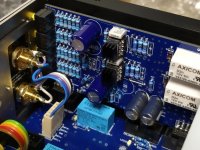Well know here! As I need to solder my xlr cables this is no problem for me. All IO shields are changeable so if one designs his preamp case it is no problem to use "normal" sized xlr connectors.
... some progress on the backpanel ...
The right picture shows the gain setting in detail. The hex switch allows 16 gain settings from -15dB to +10dB.
BR, Toni
The right picture shows the gain setting in detail. The hex switch allows 16 gain settings from -15dB to +10dB.
BR, Toni
Attachments
Last edited:
... bottom view ...
2.5mm stainless steel bottom and 10mm thick aluminium black anodized side panels
Below with similar design the SA2015 - 4 Channel power amplifier. Each amp module with 3 pairs IRFP240/9240 8/4R, 70W/140W continuous rms output power.
2.5mm stainless steel bottom and 10mm thick aluminium black anodized side panels
Below with similar design the SA2015 - 4 Channel power amplifier. Each amp module with 3 pairs IRFP240/9240 8/4R, 70W/140W continuous rms output power.
Attachments
Last edited:
... only front panel missing ...
preamp is running like a charm! 😎
Some pictures about the controller config features.
Have fun, Toni
preamp is running like a charm! 😎
Some pictures about the controller config features.
Have fun, Toni
Attachments
Balance is realized in software as we have so many 0.5dB steps from -63.5dB to +12dB (152 individual steps in total)
You can change balance temporarily or save it to survive a MCU reboot.
For the eeprom to last a very long time I have implemented a very simple wear leveling algorithm.
Other settings (Menu "Setup") are contrast and delta volumes between channels.
{ 11, 1, 0, "Boot volume" , TYP_BOOTVOLUME
{ 0, 2, 0, "Delta Vol. %s" , TYP_INPUT1VOLUME
{ 1, 3, 0, "Delta Vol. %s" , TYP_INPUT2VOLUME
{ 2, 4, 0, "Delta Vol. %s" , TYP_INPUT3VOLUME
{ 3, 5, 0, "Delta Vol. %s" , TYP_INPUT4VOLUME
{ 4, 6, 0, "Delta Vol. %s" , TYP_INPUT5VOLUME
{ 5, 7, 0, "Delta Vol. %s" , TYP_INPUT6VOLUME
{ 6, 8, 0, "Delta Vol. %s" , TYP_INPUT7VOLUME
{ 7, 9, 0, "Delta Vol. %s" , TYP_INPUT8VOLUME
{ 8, 10, 0, "Contrast dimmed" , TYP_LCD_DIMMED
{ 9, 11, 0, "Contrast normal" , TYP_LCD_NORMAL
{ 10, 0, 0, "Factory reset" , TYP_FACTORY_RESET
You can change balance temporarily or save it to survive a MCU reboot.
For the eeprom to last a very long time I have implemented a very simple wear leveling algorithm.
Other settings (Menu "Setup") are contrast and delta volumes between channels.
{ 11, 1, 0, "Boot volume" , TYP_BOOTVOLUME
{ 0, 2, 0, "Delta Vol. %s" , TYP_INPUT1VOLUME
{ 1, 3, 0, "Delta Vol. %s" , TYP_INPUT2VOLUME
{ 2, 4, 0, "Delta Vol. %s" , TYP_INPUT3VOLUME
{ 3, 5, 0, "Delta Vol. %s" , TYP_INPUT4VOLUME
{ 4, 6, 0, "Delta Vol. %s" , TYP_INPUT5VOLUME
{ 5, 7, 0, "Delta Vol. %s" , TYP_INPUT6VOLUME
{ 6, 8, 0, "Delta Vol. %s" , TYP_INPUT7VOLUME
{ 7, 9, 0, "Delta Vol. %s" , TYP_INPUT8VOLUME
{ 8, 10, 0, "Contrast dimmed" , TYP_LCD_DIMMED
{ 9, 11, 0, "Contrast normal" , TYP_LCD_NORMAL
{ 10, 0, 0, "Factory reset" , TYP_FACTORY_RESET
Attachments
Last edited:
Looks great! What software did you use for designing the front/back panels?... today the front panel arrived - cnc engraved, machined from both sides, engravings colored ...
Thanks goes to Schaeffer AG for this high quality!
QCAD Professional for the whole project. Frontplatten Designer for the back and front panels (english version: Frontpanel Designer)
Hi Tony,
can you explain how it sounds when you move the bass boost from 15 Hz to 80 Hz? I can not imagine that. Does that sound wider?
can you explain how it sounds when you move the bass boost from 15 Hz to 80 Hz? I can not imagine that. Does that sound wider?
It depends on the used speakers and the music you are playing. With the frequency knob you shift the 10dB peak from 15Hz to 80Hz. I will use it to create a "loudness curve" for my typical listening volume.
If you turn it to 80Hz it may correct missing bass from smaller speakers and vice versa.
The attached picture shows the peaks when you turn the bass frequency knob. Similar - of course mirrored - function when you use the treble frequency.
Playing louder I would recommend the "direct" function to bypass the tone control.
Attached a picture showing D.Self measurements on the tone control p425 ("Small Signal Audio Design - Second Edition"). I really like this book!
Have fun, Toni
If you turn it to 80Hz it may correct missing bass from smaller speakers and vice versa.
The attached picture shows the peaks when you turn the bass frequency knob. Similar - of course mirrored - function when you use the treble frequency.
Playing louder I would recommend the "direct" function to bypass the tone control.
Attached a picture showing D.Self measurements on the tone control p425 ("Small Signal Audio Design - Second Edition"). I really like this book!
Have fun, Toni
Attachments
Quick checks / measurements with Volume control @ 0dB, single ended input 1, single ended output
Have fun, Toni
- 110 dB SNR 80kHz bw vs 2.7VRMS output level
- 119 dB SNR A-w vs 2.7VRMS output level
- 8.6 µV output noise 80 kHz bw
- 3.3 µV output noise A-w
- 0.00048% THD+N 1kHz 80 kHz bw @ 2.7V rms output level
- 0.00098% THD+N 20 kHz bw 80 kHz @ 2.7V rms output level
- 0.00038% THD+N 1kHz A-w @ 2.7V rms output level
- 0.00028% THD+N 20 kHz A-w @ 2.7V rms output level
Have fun, Toni
Time for a APx555 ;-)These values are my measurement limits (Analyzer Levear VP-7723D) so the preamplifier will perform much better.
Have fun, Toni
- Home
- Source & Line
- Analog Line Level
- SA2022 - Modular High End Analog Precision Preamp (with headphone amp, digital controlled relay volume, monitor output, IR remote, SE and bal. I/O)



